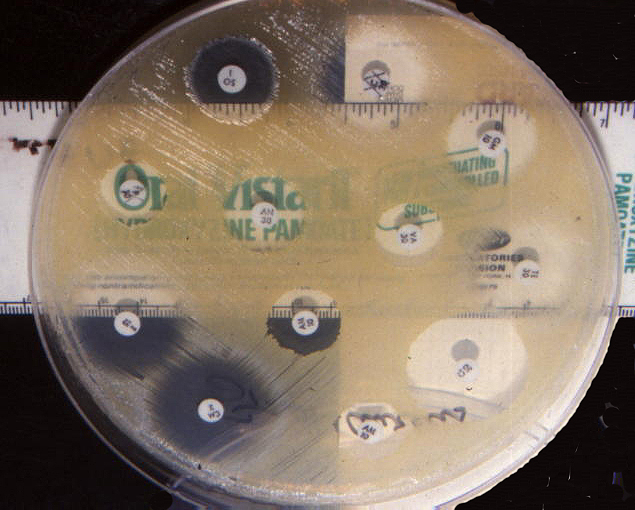



![]()
The disk-diffusion method (Kirby-Bauer) is more suitable for routine testing in a clinical laboratory where a large number of isolates are tested for susceptibility to numerous antibiotics. An agar plate is uniformly inoculated with the test organism and a paper disk impregnated with a fixed concentration of an antibiotic is placed on the agar surface. Growth of the organism and diffusion of the antibiotic commence simultaneously resulting in a circular zone of inhibition in which the amount of antibiotic exceeds inhibitory concentrations. The diameter of the inhibition zone is a function of the amount of drug in the disk and susceptibility of the microorganism.
This test must be rigorously standardized since zone size is also dependent on inoculum size, medium composition, temperature of incubation, excess moisture and thickness of the agar. If these conditions are uniform, reproducible tests can be obtained and zone diameter is only a function of the susceptibility of the test organism.
Zone diameter can be correlated with susceptibility as measured by the dilution method. Further correlations using zone diameter allow the designation of an organism as "susceptible", "intermediate", or "resistant" to concentrations of an antibiotic which can be attained in the blood or other body fluids of patients requiring chemotherapy.

Procedure:
- Make a suspension at an appropriate turbidity of the bacterial culture to be tested.
- Place a sterile cotton swab in the bacterial suspension and remove the excess fluid by pressing and rotating the cotton against the inside of the tube above the fluid level. The swab is streaked in at least three directions over the surface of the Mueller-Hinton agar to obtain uniform growth. A final sweep is made around the rim of the agar. Be sure to streak for confluency.
- Allow the plates to dry for five minutes.
- Using sterile forceps, place disks containing the following antibiotics on the plate: penicillin G, ampicillin, cephalothin, erythromycin, tetracycline, methicillin, streptomycin or other appropriate antibiotic disks.
- Incubate the plates within 15 minutes after applying the disks. The plates should be incubated soon after placing the disks since the test is standardized under conditions where diffusion of the antibiotic and bacterial growth commence at approximately the same time.
- Following overnight incubation, measure the diameter of the zone of growth inhibition around each disk to the nearest whole mm. Examine the plates carefully for well-developed colonies within the zone of inhibition.
- Using a standard table of antibiotic susceptibilities, determine if the strain is resistant, intermediate, or susceptible to the antibiotics tested.
![]()
| Lecture Syllabus | General Course Information | Grade Determination |
| Laboratory Syllabus | Interesting WebSite Links | Lab Safety |